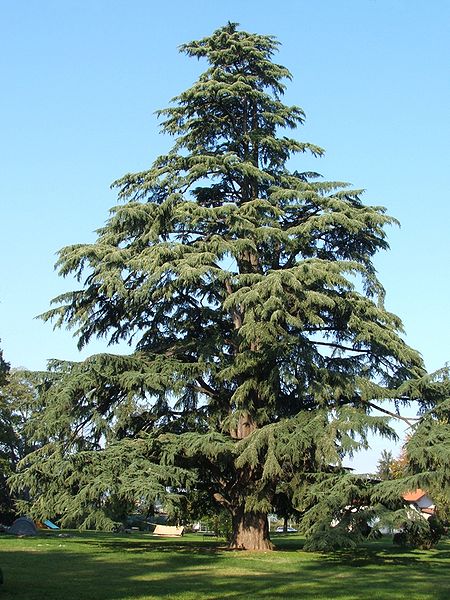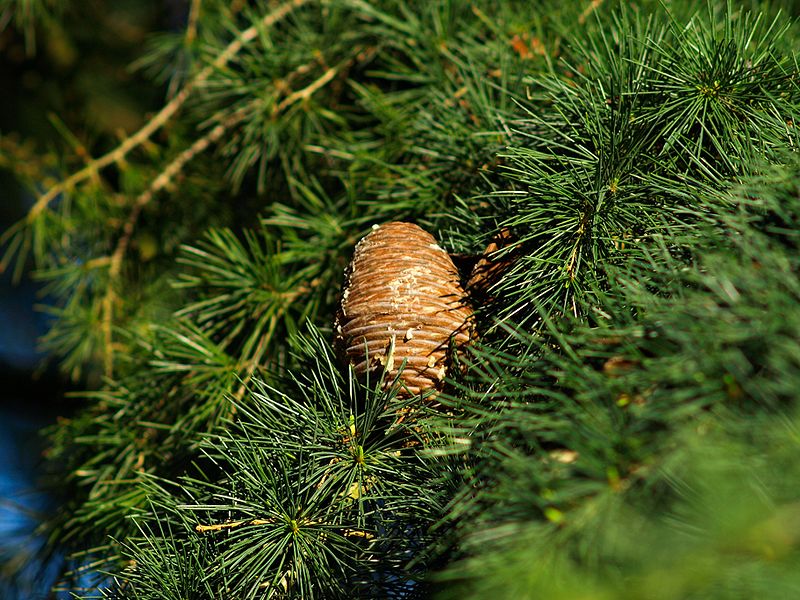 |
|
http://commons.wikimedia.org/wiki/User:Luigi_Chiesa |
 |
| http://commons.wikimedia.org/wiki/User:Donromano |
Translate this page:
Summary
Bloom Color: Unknown.
Main Bloom Time: Early spring, Late spring, Mid spring.Form: Pyramidal.
Physical Characteristics

 Cedrus deodara is an evergreen Tree growing to 33 m (108ft) by 10 m (32ft) at a medium rate.
Cedrus deodara is an evergreen Tree growing to 33 m (108ft) by 10 m (32ft) at a medium rate.
See above for USDA hardiness. It is hardy to UK zone 8. It is in leaf all year, in flower from October to November, and the seeds ripen from October to December. The species is monoecious (individual flowers are either male or female, but both sexes can be found on the same plant) and is pollinated by Wind.
Suitable for: light (sandy), medium (loamy) and heavy (clay) soils and prefers well-drained soil. Suitable pH: mildly acid, neutral and basic (mildly alkaline) soils and can grow in very alkaline soils.
It cannot grow in the shade. It prefers dry or moist soil and can tolerate drought. The plant can tolerates strong winds but not maritime exposure.
It cannot tolerate atmospheric pollution.
UK Hardiness Map
US Hardiness Map
Synonyms
Plant Habitats
Woodland Garden Canopy;
Edible Uses
References More on Edible Uses
Medicinal Uses
Plants For A Future can not take any responsibility for any adverse effects from the use of plants. Always seek advice from a professional before using a plant medicinally.
Antidote Astringent Carminative Diaphoretic Diuretic Dysentery Skin TB
Urinary
The heartwood is carminative, diaphoretic, diuretic and expectorant[240, 272]. A decoction of the wood is used in the treatment of fevers, flatulence, pulmonary and urinary disorders, rheumatism, piles, kidney stones, insomnia, diabetes etc[240, 254]. It has been used as an antidote to snake bites[240, 243]. The plant yields a medicinal essential oil by distillation of the wood, it is used in the treatment of phthisis, bronchitis, blennorrhagia and skin eruptions[4, 158, 240]. A resin obtained from the wood is used externally to treat bruises, skin diseases and injuries to joints[272]. The bark is astringent. It has proved useful in the treatment of fevers, diarrhoea and dysentery[240, 243]. In Ayurvedic medicine the leaves are used in the treatment of tuberculosis[254]. An oil obtained from the seed is diaphoretic[272]. It is applied externally to treat skin diseases[272].
References More on Medicinal Uses
The Bookshop: Edible Plant Books
Our Latest books on Perennial Plants For Food Forests and Permaculture Gardens in paperback or digital formats.

Edible Tropical Plants
Food Forest Plants for Hotter Conditions: 250+ Plants For Tropical Food Forests & Permaculture Gardens.
More

Edible Temperate Plants
Plants for Your Food Forest: 500 Plants for Temperate Food Forests & Permaculture Gardens.
More

More Books
PFAF have eight books available in paperback and digital formats. Browse the shop for more information.
Shop Now
Other Uses
Shelterbelt Wood
A fairly wind-tolerant tree, it can be used in shelterbelt plantings[200]. Wood - moderately hard, durable, aromatic, fine and even grained. Resistant to termites, it is used for construction, furniture, boats etc[51, 61, 145, 158, 272]. A valuable timber, but a poor fuel, producing a lot of smoke as it burns[51, 272].
Special Uses
Espalier Scented Plants
References More on Other Uses
Cultivation details
Landscape Uses:Espalier, Specimen Thrives on most soils, being very tolerant of dry sites and of drought when it is established[81, 200]. Succeeds in very chalky soils[200]. Prefers a rich loam or a sandy clay in full sun[1]. Succeeds in warm dry areas with less than 40cm of rain a year, but also in areas with cool summers and up to 200cm of rain[200]. Dislikes atmospheric pollution[11]. Plants are fairly wind tolerant[200]. This species is the least hardy of the genus and does not always succeed outdoors in Britain[11] although some clones are hardy down to zone 5 and grow well in this country[200]. The hardiest forms come from the west of its range[81]. Trees thrive best in the cooler and moister areas of Britain[11]. Small trees less than 50cm tall establish much more quickly and better than taller trees, those that are more than 2 metres tall are difficult to establish[200]. Larger trees will check badly and hardly put on any growth for several years. This also badly affects root development and wind resistance[200]. Plants are said to live for up to 600 years in the wild[227]. New growth takes place from May to the end of September and can exceed 1 metre per year, slowing down as the tree gets larger and virtually ceasing by the time the tree is 20 metres tall[185]. This species is sometimes cultivated for timber in some parts of S. Europe[50]. Small male cones are formed on the lower branches of trees, whilst the larger female cones are formed on higher branches[238]. These female cones persist on the tree for 2 - 3 years before breaking up[238]. Trees are notably susceptible to honey fungus[200]. The whole plant is aromatic[245]. Special Features:Attractive foliage, Not North American native, Inconspicuous flowers or blooms.
References Carbon Farming Information and Carbon Sequestration Information
Temperature Converter
Type a value in the Celsius field to convert the value to Fahrenheit:
Fahrenheit:
The PFAF Bookshop
Plants For A Future have a number of books available in paperback and digital form. Book titles include Edible Plants, Edible Perennials, Edible Trees,Edible Shrubs, Woodland Gardening, and Temperate Food Forest Plants. Our new book is Food Forest Plants For Hotter Conditions (Tropical and Sub-Tropical).
Shop Now
Plant Propagation
Seed - collect the cones in winter and keep in a warm room until they open[1]. Sow immediately in a cold frame[78]. One report says that a short cold stratification of one month improves germination rates[113]. Keep the seed pot moist, but be careful because the young seedlings are very prone to damp off, keep them well ventilated[113]. Prick out the seedlings into individual pots when they are large enough to handle. Grow them on in a cold frame for their first winter and plant them out into their permanent positions in late spring or early summer. Give them some protection from winter cold for their first winter or two outdoors[K]. Cuttings of terminal shoots can be tried in a frame in November but they are very difficult[113].
Other Names
If available other names are mentioned here
Native Range
TEMPERATE ASIA: Afghanistan (east), China (Xizang Zizhiqu (southwest)) TROPICAL ASIA: India (Himachal Pradesh, Jammu and Kashmir, Uttar Pradesh), Nepal (east), Pakistan (northeast)
Weed Potential
Right plant wrong place. We are currently updating this section.
Please note that a plant may be invasive in one area but may not in your area so it's worth checking.
Conservation Status
IUCN Red List of Threatened Plants Status :

Growth: S = slow M = medium F = fast. Soil: L = light (sandy) M = medium H = heavy (clay). pH: A = acid N = neutral B = basic (alkaline). Shade: F = full shade S = semi-shade N = no shade. Moisture: D = dry M = Moist We = wet Wa = water.
Now available:
Food Forest Plants for Mediterranean Conditions
350+ Perennial Plants For Mediterranean and Drier Food Forests and Permaculture Gardens.
[Paperback and eBook]
This is the third in Plants For A Future's series of plant guides for food forests tailored to
specific climate zones. Following volumes on temperate and tropical ecosystems, this book focuses
on species suited to Mediterranean conditions—regions with hot, dry summers and cool, wet winters,
often facing the added challenge of climate change.
Read More
Expert comment
Author
(Roxb. ex D.Don.)G.Don.
Botanical References
1151200
Links / References
For a list of references used on this page please go here
Readers comment